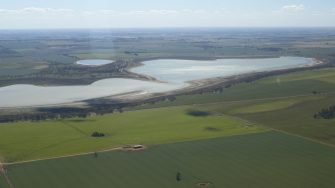
Date: Tuesday, October 19, 2021
Project: Eastern Australian Waterbird Survey
Observers: Richard Kingsford & John Porter
Pilot: James Barkell
We headed from Sydney to the south. The first waterbodies we surveyed were the artificial Cordeaux and Avon Dams, part of Sydney's water supply. The flying conditions were beautiful, little wind and the morning sun on the water. Even though these are large bodies of water, there are hardly any waterbirds. Just the odd great cormorant. The reason is they’re so deep that there aren’t many feeding areas for waterbirds.
Cordeaux Dam, part of Sydney’s water supply.
We then headed across to the coast and surveyed Lake Illawarra, just near Wollongong. It always has about a hundred black swans, flocks of silver gulls, pelicans and the odd black duck. There weren't that many waterbirds for such a big area of water.
This was the coastal east end of survey band 3, after which we started heading south to the most eastern point of survey band 2, around Merimbula on the south coast of New South Wales. We didn’t go far before it became clear that the southerly front coming through had too many low clouds and rain for low level surveys. We postponed this part of the survey band, until we fly down to Victoria in the coming weeks.
Instead, we headed straight to Albury to refuel and over a few large dams on the way in.
Talbingo Dam on the Tumut River.
Flying over Hume Dam on the way in to Albury.
Heading south from Albury past the dam wall on Hume Dam.
From there we went south and surveyed parts of the Kiewa, Ovens and King Rivers in Victoria. There were patches of water on the floodplains beside the rivers, with flocks of straw-necked ibis and white ibis; there were also a few wood ducks and black duck along the main river channels.
After this, we headed north to the River Murray. This year has been so disjointed, in terms of planning with Covid border restrictions, that we had to pick up some of the Murray-Darling wetlands as we went and one that we routinely survey was Lake Mulwala or Yarrawonga Weir.
This big body of water on the River Murray usually has just a few swans and cormorants. But surprisingly today, we found small colonies of white ibis and straw-necked ibis. About 100 nests of each. We also found our regular small colony of about 200 pelican nests, breeding on an island.
Surveying Lake Mulwala.
Once we were done here, we then headed south to pick up where we had left off on survey band 2, at Lake Mokoan or the Winton wetlands in Victoria. This area used to be a major storage and not particularly productive for waterbirds.
It was great to see the shallow water spread across the system, making a large wetland, full of aquatic plants poking out of the water. With so much productivity, there were 50 or more each of Pacific herons and white-faced herons which is surprising. You only find these numbers on very productive wetlands, probably indicating large numbers of frogs and large invertebrates. There were also straw-necked ibis, lots of swans, a few grey teal, black duck and even a magpie goose which was another surprise. The restoration of these wetlands looked a picture, reflecting what you can do when you want to rehabilitate a wetland system, used as a dam.
Winton wetlands.
From here we headed west, surveying the odd farm dam with wood ducks and black duck, until we got just south of the town of Shepparton. Here, the sewage works can have large numbers of pink-eared duck. We had thought they might all have headed inland with so much water. But, there were still about 500 of them here.
From here it was a quick flight over the large irrigation channel system, until we reached Warranga Basin, a huge dam which hardly ever has any waterbirds.
Irrigation channels system.
The storage basin is almost the equivalent of a wetland desert, probably because the rich nutrients have not built up over the tens of thousands of years of a natural wetland.
Waranga storage basin.
It was then west to Wallenjoe or Corop wetlands, which are part of the Goulburn River system but also used to regulate or store water. At times, these can be amazing wetlands when they're extensive and there's water in all the swamps and lakes. We were surprised to find how dry they were, with hardly any of them flooded.
One of the dry lake beds of the Corop wetlands.
We were under the misapprehension that, in this wet year, there would be plenty of water here. Cooper Lake nearly always has water but was dry. Only a couple of the northern lakes held water and even these were obviously drying back. As a result, they were quite shallow supporting hundreds of swans, Australian shelducks and grey teal.
The only lakes with water in the Corop wetlands.
We finished and flew to Deniliquin in New South Wales for the night.
By Richard Kingsford
